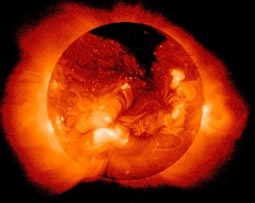“I See God’s Glory Every Day”: NASA Scientist Working on Solar Probe Mission Describes “Amazing Voyage of Discovery”“It’s a spacecraft loaded with technological breakthroughs that will solve many of the largest mysteries about our star, including finding out why the sun’s corona is so much hotter than its surface.” -Nicola Fox
Erik Rosales : May 29, 2018 : CBN News
 (Greenbelt, MD)—[CBN News] For more than a decade, NASA scientist Adam Szabo has been working on the $1.6-billion Parker Solar Probe mission. (Screengrab via CBN News)
(Greenbelt, MD)—[CBN News] For more than a decade, NASA scientist Adam Szabo has been working on the $1.6-billion Parker Solar Probe mission. (Screengrab via CBN News)
Szabo told CBN News, “I see God’s hand in the wonders of space and even our existence here on earth couldn’t happen without a divine Creator.”
The mission will send a probe about the size of a compact automobile into space.
It will make 24 orbits around the sun.
God’s Handiwork on Display in Space
At its closest approach, the Parker Solar probe will fly within 3.7 million miles of the sun’s surface, more than eight times closer than any other spacecraft and more than eight times closer than Mercury.
Szabo says he sees God’s hand in the wonders of space every day. “When I look at how much energy there is in the sun and all that energy coming towards us, yet that energy is extremely dangerous if we were just exposed to it. Look at this spacecraft. Just to fly by there [the sun] we had to take extreme protective measures just for robotic stuff to survive never mind human beings,” Szabo said.
The Parker Space Probe Mission
Set to launch on July 31, 2018, from Cape Canaveral, Florida, the Parker Solar Probe will study how heat and energy move through the sun’s atmosphere, known as the corona, which is hotter than the sun’s surface.
It will send data back to Earth, where NASA scientists will explore what accelerates the solar winds that affect Earth and other planets.
 The probe is named after Eugene Parker, who first hypothesized that high-speed matter and magnetism constantly escaped the sun and that it affected the planets and space throughout our solar system. (Screengrab via CBN News)
The probe is named after Eugene Parker, who first hypothesized that high-speed matter and magnetism constantly escaped the sun and that it affected the planets and space throughout our solar system. (Screengrab via CBN News)
This phenomenon is now known as the solar wind.
Solar Probe to Answer Many Questions
“Parker Solar Probe is going to answer questions about solar physics that we’ve puzzled over for more than six decades,” Parker Solar Probe Project scientist Nicola Fox of the Johns Hopkins University Applied Physics Laboratory, said in a statement.
“It’s a spacecraft loaded with technological breakthroughs that will solve many of the largest mysteries about our star, including finding out why the sun’s corona is so much hotter than its surface. And we’re very proud to be able to carry Gene’s name with us on this amazing voyage of discovery,” she added.
Six onboard instruments will also measure the sun’s electric and magnetic fields, as well as its solar winds and other phenomena.
Space weather may not sound like something that concerns us here on Earth, but scientists estimate solar events that happen without warning could cause trillions of dollars in damage in the US and a serious coronal mass ejection, or CME, could leave parts of the country without power for a year or more.
The probe will blast off inside a Delta IV rocket from Cape Canaveral, Florida.
Scientists say the hardest thing will be to say goodbye to it forever.
Probe Carries 1.1 Million Names
The probe will carry over 1.1 million people’s names to the sun this July, the US space agency said.
In March 2017, the public was invited to send their names to the sun aboard humanity’s first mission to ‘touch’ a star.
A total of 1,137,202 names were submitted, and a memory card with the names was installed on the spacecraft on May 18—three months before the scheduled launch on July 31.
The card was mounted on a plaque bearing a dedication to and a quote from the mission’s namesake Eugene Parker.

